BASIC SAFETY INFORMATION
•
Dangers, Warnings, and Cautions alert you to important operating instructions or to
potentially hazardous situations. Pay special attention to these items.
•
This smoke/CO alarm is approved for use in single-family residences. It is NOT designed for marine or RV use.
•
This combination Smoke/Carbon Monoxide alarm has two separate alarms. The CO alarm is not designed to detect fire or any other gas.
It will only indicate the presence of carbon monoxide gas at the sensor. Carbon monoxide gas may be present in other areas. The smoke
alarm will only indicate the presence of smoke that reaches the sensor. The smoke alarm is not designed to sense gas, heat or flames.
•
This smoke/CO alarm cannot operate without working batteries. Removing the batteries for any reason,
or failing to replace the batteries at the end of their service life, removes your protection.
•
NEVER ignore any alarm. See “If Your Smoke/CO Alarm Sounds” for more information on how
to respond to an alarm. Failure to respond can result in injury or death.
•
The Silence Features are for your convenience only and will not correct a problem. See “Using the Silence Features” for
details. Always check your home for a potential problem after any alarm. Failure to do so can result in injury or death.
•
Test this smoke/CO alarm once a week. If the alarm ever fails to test correctly, have it replaced
immediately! If the alarm is not working properly, it cannot alert you to a problem.
•
This product is intended for use in ordinary indoor locations of family living units. It is not designed to measure CO levels in compliance with
Occupational Safety and Health Administration (OSHA) commercial or industrial standards. Individuals with medical conditions that may
make them more sensitive to carbon monoxide may consider using warning devices which provide audible and visual signals for carbon
monoxide concentrations under 30 ppm. For additional information on carbon monoxide and your medical condition contact your physician.
INSTALLATION
WHERE TO INSTALL THIS ALARM
Minimum coverage for smoke alarms, as recommended by the National Fire Protection Association (NFPA), is one smoke alarm on every level, in every
sleeping area, and in every bedroom (See “Regulatory Information for Smoke Alarms” for details on the NFPA recommendations). For CO alarms, the
National Fire Protection Association (NFPA) recommends that a CO alarm should be centrally located outside of each separate sleeping area in the
immediate vicinity of the bedrooms. For added protection, install additional CO alarms in each separate bedroom, and on every level of your home.
NOTE: For added protection, install an additional smoke/CO alarm at least 15 feet (4.6 meters) away from the furnace or fuel burning heat source where
possible. In smaller homes or in manufactured homes where this distance cannot be maintained, install the alarm as far away as possible from the furnace or
other fuel burning source. Installing the alarm closer than 15 feet (4.6 meters) will not harm the alarm, but may increase the frequency of unwanted alarms.
IN GENERAL, INSTALL COMBINATION SMOKE AND CARBON MONOXIDE ALARMS:
•
On every level of your home, including finished attics and basements.
•
Inside every bedroom, especially if people sleep with the door partly or completely closed.
•
In the hall near every sleeping area. If your home has multiple sleeping areas, install a unit in each.
If a hall is more than 40 feet (12 meters) long, install a unit at each end.
•
At the top of first-to-second level stairs.
•
At the bottom of the basement stairs.
•
For additional coverage, install alarms in all rooms, halls, and storage areas, where temperatures normally remain between 40˚ F and 100˚ F (4.4˚ C and 37.8˚ C).
Smoke Alarm
One on every level and
in every bedroom
Carbon Monoxide Alarm
One on every level and
in every bedroom
Fire Extinguisher
One on every level, plus
kitchen and garage
HALLWAY BEDROOMBEDROOM
GARAGE
LIVING ROOM KITCHEN
BASEMENT
•
When installing on the wall, the top edge of smoke alarms should be placed between 4 inches (102 mm) and 12 inches (305 mm) from the wall/ceiling line.
•
When installing on the ceiling, place the alarm as close to the center as possible.
•
In either case, install at least 4 inches (102 mm) from where the wall and ceiling meet. See “Avoiding Dead Air Spaces” for more information.
NOTE: For any location, make sure no door or other obstruction could keep carbon monoxide or smoke from reaching the alarm.
INSTALLING SMOKE/CO ALARMS IN MOBILE HOMES
For minimum security install one smoke/CO alarm as close to each sleeping area as possible. For more security, put one unit in
each room. Many older mobile homes (especially those built before 1978) have little or no insulation. If your mobile home is not
well insulated, or if you are unsure of the amount of insulation, it is important to install units on inside walls only.
WHERE THIS ALARM SHOULD NOT BE INSTALLED
DO NOT LOCATE THIS SMOKE/CO ALARM:
•
In garages, furnace rooms, crawl spaces and unfinished attics. Avoid extremely dusty, dirty or greasy areas.
•
Where combustion particles are produced. Combustion particles form when something burns. Areas to avoid include poorly ventilated
kitchens, garages, and furnace rooms. Keep units at least 20 feet (6 meters) from the sources of combustion particles (stove, furnace, water
heater, space heater) if possible. In areas where a 20-foot (6 meter) distance is not possible – in modular, mobile, or smaller homes, for
example – it is recommended the smoke alarm be placed as far from these fuel-burning sources as possible. The placement recommendations
are intended to keep these alarms at a reasonable distance from a fuel-burning source, and thus reduce “unwanted” alarms. Unwanted
alarms can occur if a smoke alarm is placed directly next to a fuel-burning source. Ventilate these areas as much as possible.
•
Within 5 feet (1.5 meters) of any cooking appliance. In air streams near kitchens. Air currents can
draw cooking smoke into the smoke sensor and cause unwanted alarms.
•
In extremely humid areas. This alarm should be at least 10 feet (3 meters) from a shower, sauna, humidifier,
vaporizer, dishwasher, laundry room, utility room, or other source of high humidity.
•
In direct sunlight.
•
In turbulent air, like near ceiling fans or open windows. Blowing air may prevent CO or smoke from reaching the sensors.
•
In areas where temperature is colder than 40˚ F (4.4˚ C) or hotter than 100˚F (37.8˚ C). These areas include non-
airconditioned crawl spaces, unfinished attics, uninsulated or poorly insulated ceilings, porches, and garages.
•
In insect infested areas. Insects can clog the openings to the sensing chamber.
•
Less than 12 inches (305 mm) away from fluorescent lights. Electrical “noise” can interfere with the sensor.
•
In “dead air” spaces. See “Avoiding Dead Air Spaces”.
AVOIDING DEAD AIR SPACES
“Dead air” spaces may prevent smoke from reaching the smoke alarm. To avoid dead air spaces, follow installation recommendations below.
On ceilings, install smoke alarms as close to the center of the ceiling as possible. If this is not possible,
install the smoke alarm at least 4 inches (102 mm) from the wall or corner.
For wall mounting (if allowed by building codes), the top edge of smoke alarms should be placed between 4 inches
(102 mm) and 12 inches (305 mm) from the wall/ceiling line, below typical “dead air” spaces.
On a peaked, gabled, or cathedral ceiling, install the first smoke alarm within 3 feet (0.9 meters) of the peak of the ceiling, measured horizontally. Additional
smoke alarms may be required depending on the length, angle, etc. of the ceiling’s slope. Refer to NFPA 72 for details on requirements for sloped or peaked ceilings.
STEP BY STEP GUIDE TO PROGRAMMING THIS ALARM
FOR FIRST TIME AND WHEN CHANGING BATTERIES
Action: Alarm Will Say:
Activate alarm.
“Welcome, First Alert carbon monoxide and smoke alarm.”
“No location programmed” if first time or “[Location, example:
“Hallway”] location programmed” when changing batteries.
“To select location, press and hold test button now.”
Press & hold test button if you would like to
program the location or change the location of the
alarm. Release button after alarm responds.
“To save location, press and hold test button after location is
heard.” alarm will speak list of locations (see below).
After you hear the location of where you are placing
the alarm, Press & hold the test Button.
“[Location, example: “Hallway”] location saved.” If no location is chosen: “No location saved.”
Your alarm has now been programmed for the location of your choice.
Available locations: Basement, Hallway, Office, Child’s Bedroom, Kitchen, Utility Room, Dining Room,
Living Room, Family Room, Master Bedroom, Guest Bedroom, No Location
For reprogramming: When it is necessary to reprogram the alarm after the unit has been activated and is in normal
operation: Tap the test button 5 times to reset the alarm to again access the programming menu.
STEP BY STEP GUIDE TO PROGRAMMING THIS ALARM
WHAT YOU WILL SEE AND HEAR WITH THIS ALARM
Under Normal Operations Voice: Silent Horn: Silent Power LED: Flashes Green once a minute
When You Test the Alarm
Voice: “Testing.” “Warning, evacuate smoke in [Location, example: “Hallway”]. Evacuate.”
Horn: 3 beeps, pause, 3 beeps, voice
Power LED: Flashes Red followed by Voice: “Warning, evacuate carbon
monoxide in [Location, example: “Hallway”]. Evacuate.”
Horn: 4 beeps, pause, 4 beeps, voice Power LED: Flashes Red
If Battery Becomes Low
Voice: “Replace battery in [Location, example “Hallway”].” Repeated every 5 hours
Horn: chirps once a minute
Power LED: Flashes Green approximately once a minute
If Alarm is Not Operating Properly
(MALFUNCTION SIGNAL)
Voice: “Detector error in [Location, example “Hallway”], please see manual.” Repeated every 5 hours
Horn: 3 chirps every minute
Power LED: Three Green flashes approximately once a minute
Alarm Has Reached its End of Life
Voice: “Detector error in [Location, example “Basement”], please see manual.” Repeated every 5 hours
Horn: 5 chirps every minute
Power LED: Five Green flashes approximately once a minute
Alarm Levels of CO are Detected
Voice: “Warning, evacuate carbon monoxide in [Location, example: “Hallway”]. Evacuate.” “____ ppm.”
Horn: 4 beeps, pause, 4 beeps, voice*
Power LED: Flashes Red
Smoke is Detected
Voice: “Warning, evacuate smoke in [Location, example: “Hallway”]. Evacuate.”
Horn: 3 beeps, pause, 3 beeps, voice
Power LED: Flashes Red
Smoke Alarm is Silenced Voice: Silent Horn: Off Power LED: Flashes Red
CO Alarm is Silenced Voice: Silent Horn: Off Power LED: Flashes Red
IMPORTANT! PLEASE READ CAREFULLY AND SAVE.
The warnings/limitations card and manual contains important information
about your smoke & carbon monoxide (CO) alarm’s operation. If you are
installing this alarm for use by others, you must leave this manual—or a copy
of it—with the end user. Reference product card for additional information.
Para el manual del usuario en español, por favor visite www.firstalert.com.
USER’S MANUAL
10-YEAR SEALED BATTERY COMBINATION CARBON
MONOXIDE & SMOKE ALARM WITH VOICE & LOCATION
SEPARATE SENSORS TO DETECT
SMOKE AND CO; THE TWO ALARM
SYSTEMS WORK INDEPENDENTLY
VOICE WITH PROGRAMMABLE LOCATION
SEPARATE AUDIBLE AND VISUAL SIGNALS TO
INDICATE ALARM LEVELS OF SMOKE OR CO
10-YEAR SEALED BATTERY ALARM WITH VOICE
ALERTS AND PATENTED SMOKE ENTRY SYSTEM
Printed in Mexico
M08-0469-160324-US L 12/17
Model PC1210V
CONFORMS TO UL STD 217 AND UL STD 2034
INTRODUCTION
Thank you for choosing First Alert
®
for your smoke and carbon monoxide alarm needs. You have purchased a state-of-the-art smoke
& carbon monoxide alarm designed to provide you with early warning of a smoke and/or carbon monoxide danger.
All First Alert
®
smoke alarms conform to regulatory requirements, including UL217 and are designed to
detect particles of combustion. Smoke particles of varying number and size are produced in all fires.
Ionization technology is generally more sensitive than photoelectric technology at
detecting small particles, which tend to be produced in greater amounts by flaming fires,
which consume combustible materials rapidly and spread quickly. Sources of these fires
may include paper burning in a wastebasket, or a grease fire in the kitchen.
Photoelectric technology is generally more sensitive than ionization technology at detecting large particles,
which tend to be produced in greater amounts by smoldering fires, which may smolder for hours before
bursting into flame. Sources of these fires may include cigarettes burning in couches or bedding.
For maximum protection, use both types of smoke alarms on each level and in every bedroom of your home.
© 2018 BRK Brands, Inc. All rights reserved. Distributed by BRK Brands, Inc.
•
BRK Brands, Inc.
is a subsidiary of Newell Brands Inc. (NYSE:NWL)
•
3901 Liberty Street, Aurora, IL 60504-8122
•
Customer Service Team: (800) 323-9005
•
www.firstalert.com
•
www.brkelectronics.com
Installed on Replace by
L
OPTIONAL LOCKING FEATURE
The optional locking feature is designed to
prevent unauthorized removal of the alarm.
It is not necessary to activate the lock in
single-family households where unauthorized
alarm removal is not a concern.
Tools you will need: Needle-nose pliers or
utility knife, standard flathead screwdriver
The feature uses a locking pin which is molded
into the mounting bracket. Remove locking pin
by using needle-nose pliers or a utility knife.
To permanently remove the locking pin, insert
a flathead screwdriver between the locking pin
and the lock and pry the pin out of the lock.
TO LOCK THE
MOUNTING BRACKET
1. Using needle-nose pliers,
detach the pin from the
mounting bracket.
2. Insert the locking pin
through the hole on the
back of the smoke alarm
as shown in the diagram.
3. When you attach the alarm
to the mounting bracket the
locking pin’s head will fit into
a notch on the bracket.
TO UNLOCK THE
MOUNTING BRACKET
1. Insert a flathead screwdriver
in between the mounting
bracket and the locking pin.
2. Pry the alarm away from
the bracket by pushing up
the screwdriver and turning
the alarm counterclockwise
(left) at the same time.
HOW TO INSTALL THIS ALARM
•
This combination smoke/CO alarm was designed to be mounted on the ceiling or wall. It is not a tabletop device. You must
install this device on the ceiling or wall as outlined below. Read “Where to Install This Alarm” before starting.
This unit is designed to be mounted on the ceiling, or on the wall if necessary.
Tools you will need: pencil, drill with 3/16” (5 mm) drill bit, standard flathead screwdriver, hammer
THE PARTS OF THIS
SMOKE/CO ALARM
1. Test/Silence button
2. Dual power indicator light and
alarm indicator: Green LED
provides visual indication of an
alarm memory condition; Red
LED provides visual indication
of an alarm and hush modes
3. Speaker
1. Mounting bracket
2. Mounting slots
3. Turn this way to attach
4. Turn this way to remove
FOLLOW THESE SIMPLE STEPS
1. Hold the mounting bracket against the ceiling (or wall) so the two clusters of universal mounting holes
are aligned approximately at the 9:00 and 3:00 o’clock positions. See image. Choose one of the three
sets of holes shown, A, B or C (see image) and trace around one of the sets. Be sure to choose a top and
bottom slot on opposite sides so you can rotate the universal mounting bracket into position later. This
will make it easier in the future to remove the mounting bracket without completely removing the screws.
WARNING! Do not install this alarm over an existing electrical box. Only AC
powered units are intended for installation over electrical boxes.
2. Put the unit where it won’t get covered with dust when you drill the mounting holes.
3. Using a 3/16" (5 mm) drill bit, drill a hole through the center of the oval outlines you traced.
4. Insert the plastic screw anchors (in the plastic bag with screws) into the holes. Tap the screw
anchors gently with a hammer, if necessary, until they are flush with the ceiling or wall.
5. Install the screws but do not tighten completely. Attach the mounting bracket by aligning
the screws in the open portion of the universal mounting slots and rotating the bracket into
place. Tighten the screws until they are snug to secure the bracket. Do not over tighten.
Mounting Hole Sets
A
B
C
A
B
C
6. Activating the battery. Mount alarm to mounting bracket to activate. Once unit is activated, it cannot be turned off.
NOTE: After you activate the battery, the power indicator light may flash. (If the unit alarms, the light will blink rapidly, and the horn will
repeatedly sound 3 beeps, pause, 3 beeps.) Once the smoke alarm is on the bracket, you can rotate the alarm to adjust the alignment.
7. Test the alarm. See “Weekly Testing.”
TO PERMANENTLY DEACTIVATE THE SMOKE/CO ALARM
8. After 10 years of operation or Low Battery Warning, deactivate the alarm: Insert a tool below
edge where shown and break tab. Then slide activation switch to deactivate mode.
NOTE: At end of life or low battery indication (chirp): unit must be put into
deactivation mode to deactivate remaining stored energy in battery. Unit will no
longer function once put into this mode. Unit will resist re-mounting.
TESTING & MAINTENANCE
WEEKLY TESTING
•
NEVER use an open flame of any kind to test this unit. You might accidentally damage or set fire to the unit or to
your home. The built-in test switch accurately tests the unit’s operation as required by Underwriters Laboratories,
Inc. (UL). NEVER use vehicle exhaust! Exhaust may cause permanent damage and voids your warranty.
•
DO NOT stand close to the alarm when the horn is sounding. Exposure at close range may be
harmful to your hearing. When testing, step away when horn starts sounding.
It is important to test this unit every week to make sure it is working properly. Using the
test button is the recommended way to test this smoke/CO alarm.
You can test this smoke/CO alarm by pressing and holding the Test/Silence button on the alarm cover until alarm Voice
says “Testing” (typically 3-5 seconds). During testing, you will see and hear the following sequence:
•
The alarm Voice will say “Testing.” The Horn will sound 3 beeps, pause, 3 beeps. The alarm Voice will say “Warning,
evacuate smoke in [Location, example: “Hallway”]. Evacuate.” The Power LED flashes Red.
•
Next the Horn will sound 4 beeps, pause, 4 beeps. The alarm Voice will say “Warning, evacuate carbon
monoxide in [Location, example: “Hallway”]. Evacuate.” The LED flashes Red.
If the unit does not alarm, make sure the batteries are correctly installed, and test again. If the unit still does not alarm, replace it immediately.
REGULAR MAINTENANCE
This unit has been designed to be as maintenance free as possible, but there are a few simple things you must do to keep it working properly.
•
Test it at least once a week.
•
Clean the smoke/CO alarm at least once a month; gently vacuum the outside of the smoke/CO alarm using your household vacuum’s
soft brush attachment. A can of clean compressed air (sold at computer or office supply stores) may also be used. Follow manufacturer
instructions for use. Test the smoke/CO alarm. Never use water, cleaners or solvents since they may damage the unit.
•
If the smoke/CO alarm becomes contaminated by excessive dirt, dust and/or grime, and cannot
be cleaned to avoid unwanted alarms, replace the unit immediately.
•
Relocate the unit if it sounds frequent unwanted alarms. See “Where This Alarm Should Not Be Installed” for details.
Actual battery service life depends on the smoke/CO alarm and the environment in which it is installed. All the batteries
specified above are acceptable replacement batteries for this unit. Regardless of the manufacturer’s suggested battery life,
you MUST replace the battery immediately once the unit starts “chirping” (the “Low Battery Warning”).
FIRE SAFETY TIPS
Follow safety rules and prevent hazardous situations: 1) Use smoking materials properly. Never smoke in bed. 2) Keep matches or lighters away from
children; 3) Store flammable materials in proper containers; 4) Keep electrical appliances in good condition and don’t overload electrical circuits; 5) Keep
stoves, barbecue grills, fireplaces and chimneys grease- and debris-free; 6) Never leave anything cooking on the stove unattended; 7) Keep portable heaters
and open flames, like candles, away from flammable materials; 8) Don’t let rubbish accumulate. Keep alarms clean, and test them weekly. Replace alarms
immediately if they are not working properly. smoke alarms that do not work cannot alert you to a fire. Keep at least one working fire extinguisher on every
level, and an additional one in the kitchen. Have fire escape ladders or other reliable means of escape from an upper level in case stairs are blocked.
TROUBLESHOOTING GUIDE
IF THE ALARM... PROBLEM... YOU SHOULD...
Horn “chirps” about once per minute;
Voice: “Replace battery in
[Location]” every 5 hours
Low Battery Warning. Immediately replace the alarm.
Horn sounds 3 “chirps” every minute;
Voice: “Detector error in [Location, example
“Hallway”], please see manual” repeated every
5 hours; LED has 3 Green flashes with “chirps”.
MALFUNCTION SIGNAL. Device
is not working properly, and
needs to be replaced.
Units under warranty should be returned
to manufacturer for replacement. See
“Limited Warranty” for details.
The light flashes GREEN and the horn
sounds 5 “chirps” every minute;
Voice: “Detector error in [Location,
example “Basement”], please see
manual.” Repeated every 5 hours.
END OF LIFE SIGNAL. Alarm
needs to be replaced.
Immediately replace the alarm.
CARBON MONOXIDE ALARM ONLY:
CO alarm goes back into alarm 4
minutes after you silence it.
CO levels indicate a potentially
dangerous situation.
IF YOU ARE FEELING SYMPTOMS OF CO
POISONING, EVACUATE your home and
call 911 or the Fire Department. Refer to
“If The CO Alarm Sounds” for details.
CO alarm sounds frequently even
though no high levels of CO are
revealed in an investigation.
The CO alarm may be improperly
located. Refer to “Where to Install
This Alarm” for details.
Relocate your alarm. If frequent alarms
continue, have home rechecked for potential
CO problems. You may be experiencing
an intermittent CO problem
SMOKE ALARM ONLY:
Smoke alarm sounds when no smoke is visible.
Unwanted alarm may be caused by non-
emergency source like cooking smoke.
Silence alarm using Test/Silence button; clean
the alarm’s cover with a soft, clean cloth. If
frequent unwanted alarms continue, relocate
your alarm. alarm may be too close to a kitchen,
cooking appliance, or steamy bathroom.
If you have questions that cannot be answered by reading this manual, call the Customer Service Team at 1-800-323-9005
BASIC SAFETY INFORMATION
•
Dangers, Warnings, and Cautions alert you to important operating instructions or to
potentially hazardous situations. Pay special attention to these items.
•
This smoke/CO alarm is approved for use in single-family residences. It is NOT designed for marine or RV use.
•
This combination Smoke/Carbon Monoxide alarm has two separate alarms. The CO alarm is not designed to detect fire or any other gas.
It will only indicate the presence of carbon monoxide gas at the sensor. Carbon monoxide gas may be present in other areas. The smoke
alarm will only indicate the presence of smoke that reaches the sensor. The smoke alarm is not designed to sense gas, heat or flames.
•
This smoke/CO alarm cannot operate without working batteries. Removing the batteries for any reason,
or failing to replace the batteries at the end of their service life, removes your protection.
•
NEVER ignore any alarm. See “If Your Smoke/CO Alarm Sounds” for more information on how
to respond to an alarm. Failure to respond can result in injury or death.
•
The Silence Features are for your convenience only and will not correct a problem. See “Using the Silence Features” for
details. Always check your home for a potential problem after any alarm. Failure to do so can result in injury or death.
•
Test this smoke/CO alarm once a week. If the alarm ever fails to test correctly, have it replaced
immediately! If the alarm is not working properly, it cannot alert you to a problem.
•
This product is intended for use in ordinary indoor locations of family living units. It is not designed to measure CO levels in compliance with
Occupational Safety and Health Administration (OSHA) commercial or industrial standards. Individuals with medical conditions that may
make them more sensitive to carbon monoxide may consider using warning devices which provide audible and visual signals for carbon
monoxide concentrations under 30 ppm. For additional information on carbon monoxide and your medical condition contact your physician.
INSTALLATION
WHERE TO INSTALL THIS ALARM
Minimum coverage for smoke alarms, as recommended by the National Fire Protection Association (NFPA), is one smoke alarm on every level, in every
sleeping area, and in every bedroom (See “Regulatory Information for Smoke Alarms” for details on the NFPA recommendations). For CO alarms, the
National Fire Protection Association (NFPA) recommends that a CO alarm should be centrally located outside of each separate sleeping area in the
immediate vicinity of the bedrooms. For added protection, install additional CO alarms in each separate bedroom, and on every level of your home.
NOTE: For added protection, install an additional smoke/CO alarm at least 15 feet (4.6 meters) away from the furnace or fuel burning heat source where
possible. In smaller homes or in manufactured homes where this distance cannot be maintained, install the alarm as far away as possible from the furnace or
other fuel burning source. Installing the alarm closer than 15 feet (4.6 meters) will not harm the alarm, but may increase the frequency of unwanted alarms.
IN GENERAL, INSTALL COMBINATION SMOKE AND CARBON MONOXIDE ALARMS:
•
On every level of your home, including finished attics and basements.
•
Inside every bedroom, especially if people sleep with the door partly or completely closed.
•
In the hall near every sleeping area. If your home has multiple sleeping areas, install a unit in each.
If a hall is more than 40 feet (12 meters) long, install a unit at each end.
•
At the top of first-to-second level stairs.
•
At the bottom of the basement stairs.
•
For additional coverage, install alarms in all rooms, halls, and storage areas, where temperatures normally remain between 40˚ F and 100˚ F (4.4˚ C and 37.8˚ C).
Smoke Alarm
One on every level and
in every bedroom
Carbon Monoxide Alarm
One on every level and
in every bedroom
Fire Extinguisher
One on every level, plus
kitchen and garage
HALLWAY BEDROOMBEDROOM
GARAGE
LIVING ROOM KITCHEN
BASEMENT
•
When installing on the wall, the top edge of smoke alarms should be placed between 4 inches (102 mm) and 12 inches (305 mm) from the wall/ceiling line.
•
When installing on the ceiling, place the alarm as close to the center as possible.
•
In either case, install at least 4 inches (102 mm) from where the wall and ceiling meet. See “Avoiding Dead Air Spaces” for more information.
NOTE: For any location, make sure no door or other obstruction could keep carbon monoxide or smoke from reaching the alarm.
INSTALLING SMOKE/CO ALARMS IN MOBILE HOMES
For minimum security install one smoke/CO alarm as close to each sleeping area as possible. For more security, put one unit in
each room. Many older mobile homes (especially those built before 1978) have little or no insulation. If your mobile home is not
well insulated, or if you are unsure of the amount of insulation, it is important to install units on inside walls only.
WHERE THIS ALARM SHOULD NOT BE INSTALLED
DO NOT LOCATE THIS SMOKE/CO ALARM:
•
In garages, furnace rooms, crawl spaces and unfinished attics. Avoid extremely dusty, dirty or greasy areas.
•
Where combustion particles are produced. Combustion particles form when something burns. Areas to avoid include poorly ventilated
kitchens, garages, and furnace rooms. Keep units at least 20 feet (6 meters) from the sources of combustion particles (stove, furnace, water
heater, space heater) if possible. In areas where a 20-foot (6 meter) distance is not possible – in modular, mobile, or smaller homes, for
example – it is recommended the smoke alarm be placed as far from these fuel-burning sources as possible. The placement recommendations
are intended to keep these alarms at a reasonable distance from a fuel-burning source, and thus reduce “unwanted” alarms. Unwanted
alarms can occur if a smoke alarm is placed directly next to a fuel-burning source. Ventilate these areas as much as possible.
•
Within 5 feet (1.5 meters) of any cooking appliance. In air streams near kitchens. Air currents can
draw cooking smoke into the smoke sensor and cause unwanted alarms.
•
In extremely humid areas. This alarm should be at least 10 feet (3 meters) from a shower, sauna, humidifier,
vaporizer, dishwasher, laundry room, utility room, or other source of high humidity.
•
In direct sunlight.
•
In turbulent air, like near ceiling fans or open windows. Blowing air may prevent CO or smoke from reaching the sensors.
•
In areas where temperature is colder than 40˚ F (4.4˚ C) or hotter than 100˚F (37.8˚ C). These areas include non-
airconditioned crawl spaces, unfinished attics, uninsulated or poorly insulated ceilings, porches, and garages.
•
In insect infested areas. Insects can clog the openings to the sensing chamber.
•
Less than 12 inches (305 mm) away from fluorescent lights. Electrical “noise” can interfere with the sensor.
•
In “dead air” spaces. See “Avoiding Dead Air Spaces”.
AVOIDING DEAD AIR SPACES
“Dead air” spaces may prevent smoke from reaching the smoke alarm. To avoid dead air spaces, follow installation recommendations below.
On ceilings, install smoke alarms as close to the center of the ceiling as possible. If this is not possible,
install the smoke alarm at least 4 inches (102 mm) from the wall or corner.
For wall mounting (if allowed by building codes), the top edge of smoke alarms should be placed between 4 inches
(102 mm) and 12 inches (305 mm) from the wall/ceiling line, below typical “dead air” spaces.
On a peaked, gabled, or cathedral ceiling, install the first smoke alarm within 3 feet (0.9 meters) of the peak of the ceiling, measured horizontally. Additional
smoke alarms may be required depending on the length, angle, etc. of the ceiling’s slope. Refer to NFPA 72 for details on requirements for sloped or peaked ceilings.
STEP BY STEP GUIDE TO PROGRAMMING THIS ALARM
FOR FIRST TIME AND WHEN CHANGING BATTERIES
Action: Alarm Will Say:
Activate alarm.
“Welcome, First Alert carbon monoxide and smoke alarm.”
“No location programmed” if first time or “[Location, example:
“Hallway”] location programmed” when changing batteries.
“To select location, press and hold test button now.”
Press & hold test button if you would like to
program the location or change the location of the
alarm. Release button after alarm responds.
“To save location, press and hold test button after location is
heard.” alarm will speak list of locations (see below).
After you hear the location of where you are placing
the alarm, Press & hold the test Button.
“[Location, example: “Hallway”] location saved.” If no location is chosen: “No location saved.”
Your alarm has now been programmed for the location of your choice.
Available locations: Basement, Hallway, Office, Child’s Bedroom, Kitchen, Utility Room, Dining Room,
Living Room, Family Room, Master Bedroom, Guest Bedroom, No Location
For reprogramming: When it is necessary to reprogram the alarm after the unit has been activated and is in normal
operation: Tap the test button 5 times to reset the alarm to again access the programming menu.
STEP BY STEP GUIDE TO PROGRAMMING THIS ALARM
WHAT YOU WILL SEE AND HEAR WITH THIS ALARM
Under Normal Operations Voice: Silent Horn: Silent Power LED: Flashes Green once a minute
When You Test the Alarm
Voice: “Testing.” “Warning, evacuate smoke in [Location, example: “Hallway”]. Evacuate.”
Horn: 3 beeps, pause, 3 beeps, voice
Power LED: Flashes Red followed by Voice: “Warning, evacuate carbon
monoxide in [Location, example: “Hallway”]. Evacuate.”
Horn: 4 beeps, pause, 4 beeps, voice Power LED: Flashes Red
If Battery Becomes Low
Voice: “Replace battery in [Location, example “Hallway”].” Repeated every 5 hours
Horn: chirps once a minute
Power LED: Flashes Green approximately once a minute
If Alarm is Not Operating Properly
(MALFUNCTION SIGNAL)
Voice: “Detector error in [Location, example “Hallway”], please see manual.” Repeated every 5 hours
Horn: 3 chirps every minute
Power LED: Three Green flashes approximately once a minute
Alarm Has Reached its End of Life
Voice: “Detector error in [Location, example “Basement”], please see manual.” Repeated every 5 hours
Horn: 5 chirps every minute
Power LED: Five Green flashes approximately once a minute
Alarm Levels of CO are Detected
Voice: “Warning, evacuate carbon monoxide in [Location, example: “Hallway”]. Evacuate.” “____ ppm.”
Horn: 4 beeps, pause, 4 beeps, voice*
Power LED: Flashes Red
Smoke is Detected
Voice: “Warning, evacuate smoke in [Location, example: “Hallway”]. Evacuate.”
Horn: 3 beeps, pause, 3 beeps, voice
Power LED: Flashes Red
Smoke Alarm is Silenced Voice: Silent Horn: Off Power LED: Flashes Red
CO Alarm is Silenced Voice: Silent Horn: Off Power LED: Flashes Red
IMPORTANT! PLEASE READ CAREFULLY AND SAVE.
The warnings/limitations card and manual contains important information
about your smoke & carbon monoxide (CO) alarm’s operation. If you are
installing this alarm for use by others, you must leave this manual—or a copy
of it—with the end user. Reference product card for additional information.
Para el manual del usuario en español, por favor visite www.firstalert.com.
USER’S MANUAL
10-YEAR SEALED BATTERY COMBINATION CARBON
MONOXIDE & SMOKE ALARM WITH VOICE & LOCATION
SEPARATE SENSORS TO DETECT
SMOKE AND CO; THE TWO ALARM
SYSTEMS WORK INDEPENDENTLY
VOICE WITH PROGRAMMABLE LOCATION
SEPARATE AUDIBLE AND VISUAL SIGNALS TO
INDICATE ALARM LEVELS OF SMOKE OR CO
10-YEAR SEALED BATTERY ALARM WITH VOICE
ALERTS AND PATENTED SMOKE ENTRY SYSTEM
Printed in Mexico
M08-0469-160324-US L 12/17
Model PC1210V
CONFORMS TO UL STD 217 AND UL STD 2034
INTRODUCTION
Thank you for choosing First Alert
®
for your smoke and carbon monoxide alarm needs. You have purchased a state-of-the-art smoke
& carbon monoxide alarm designed to provide you with early warning of a smoke and/or carbon monoxide danger.
All First Alert
®
smoke alarms conform to regulatory requirements, including UL217 and are designed to
detect particles of combustion. Smoke particles of varying number and size are produced in all fires.
Ionization technology is generally more sensitive than photoelectric technology at
detecting small particles, which tend to be produced in greater amounts by flaming fires,
which consume combustible materials rapidly and spread quickly. Sources of these fires
may include paper burning in a wastebasket, or a grease fire in the kitchen.
Photoelectric technology is generally more sensitive than ionization technology at detecting large particles,
which tend to be produced in greater amounts by smoldering fires, which may smolder for hours before
bursting into flame. Sources of these fires may include cigarettes burning in couches or bedding.
For maximum protection, use both types of smoke alarms on each level and in every bedroom of your home.
© 2018 BRK Brands, Inc. All rights reserved. Distributed by BRK Brands, Inc.
•
BRK Brands, Inc.
is a subsidiary of Newell Brands Inc. (NYSE:NWL)
•
3901 Liberty Street, Aurora, IL 60504-8122
•
Customer Service Team: (800) 323-9005
•
www.firstalert.com
•
www.brkelectronics.com
Installed on Replace by
L
OPTIONAL LOCKING FEATURE
The optional locking feature is designed to
prevent unauthorized removal of the alarm.
It is not necessary to activate the lock in
single-family households where unauthorized
alarm removal is not a concern.
Tools you will need: Needle-nose pliers or
utility knife, standard flathead screwdriver
The feature uses a locking pin which is molded
into the mounting bracket. Remove locking pin
by using needle-nose pliers or a utility knife.
To permanently remove the locking pin, insert
a flathead screwdriver between the locking pin
and the lock and pry the pin out of the lock.
TO LOCK THE
MOUNTING BRACKET
1. Using needle-nose pliers,
detach the pin from the
mounting bracket.
2. Insert the locking pin
through the hole on the
back of the smoke alarm
as shown in the diagram.
3. When you attach the alarm
to the mounting bracket the
locking pin’s head will fit into
a notch on the bracket.
TO UNLOCK THE
MOUNTING BRACKET
1. Insert a flathead screwdriver
in between the mounting
bracket and the locking pin.
2. Pry the alarm away from
the bracket by pushing up
the screwdriver and turning
the alarm counterclockwise
(left) at the same time.
HOW TO INSTALL THIS ALARM
•
This combination smoke/CO alarm was designed to be mounted on the ceiling or wall. It is not a tabletop device. You must
install this device on the ceiling or wall as outlined below. Read “Where to Install This Alarm” before starting.
This unit is designed to be mounted on the ceiling, or on the wall if necessary.
Tools you will need: pencil, drill with 3/16” (5 mm) drill bit, standard flathead screwdriver, hammer
THE PARTS OF THIS
SMOKE/CO ALARM
1. Test/Silence button
2. Dual power indicator light and
alarm indicator: Green LED
provides visual indication of an
alarm memory condition; Red
LED provides visual indication
of an alarm and hush modes
3. Speaker
1. Mounting bracket
2. Mounting slots
3. Turn this way to attach
4. Turn this way to remove
FOLLOW THESE SIMPLE STEPS
1. Hold the mounting bracket against the ceiling (or wall) so the two clusters of universal mounting holes
are aligned approximately at the 9:00 and 3:00 o’clock positions. See image. Choose one of the three
sets of holes shown, A, B or C (see image) and trace around one of the sets. Be sure to choose a top and
bottom slot on opposite sides so you can rotate the universal mounting bracket into position later. This
will make it easier in the future to remove the mounting bracket without completely removing the screws.
WARNING! Do not install this alarm over an existing electrical box. Only AC
powered units are intended for installation over electrical boxes.
2. Put the unit where it won’t get covered with dust when you drill the mounting holes.
3. Using a 3/16" (5 mm) drill bit, drill a hole through the center of the oval outlines you traced.
4. Insert the plastic screw anchors (in the plastic bag with screws) into the holes. Tap the screw
anchors gently with a hammer, if necessary, until they are flush with the ceiling or wall.
5. Install the screws but do not tighten completely. Attach the mounting bracket by aligning
the screws in the open portion of the universal mounting slots and rotating the bracket into
place. Tighten the screws until they are snug to secure the bracket. Do not over tighten.
Mounting Hole Sets
A
B
C
A
B
C
6. Activating the battery. Mount alarm to mounting bracket to activate. Once unit is activated, it cannot be turned off.
NOTE: After you activate the battery, the power indicator light may flash. (If the unit alarms, the light will blink rapidly, and the horn will
repeatedly sound 3 beeps, pause, 3 beeps.) Once the smoke alarm is on the bracket, you can rotate the alarm to adjust the alignment.
7. Test the alarm. See “Weekly Testing.”
TO PERMANENTLY DEACTIVATE THE SMOKE/CO ALARM
8. After 10 years of operation or Low Battery Warning, deactivate the alarm: Insert a tool below
edge where shown and break tab. Then slide activation switch to deactivate mode.
NOTE: At end of life or low battery indication (chirp): unit must be put into
deactivation mode to deactivate remaining stored energy in battery. Unit will no
longer function once put into this mode. Unit will resist re-mounting.
TESTING & MAINTENANCE
WEEKLY TESTING
•
NEVER use an open flame of any kind to test this unit. You might accidentally damage or set fire to the unit or to
your home. The built-in test switch accurately tests the unit’s operation as required by Underwriters Laboratories,
Inc. (UL). NEVER use vehicle exhaust! Exhaust may cause permanent damage and voids your warranty.
•
DO NOT stand close to the alarm when the horn is sounding. Exposure at close range may be
harmful to your hearing. When testing, step away when horn starts sounding.
It is important to test this unit every week to make sure it is working properly. Using the
test button is the recommended way to test this smoke/CO alarm.
You can test this smoke/CO alarm by pressing and holding the Test/Silence button on the alarm cover until alarm Voice
says “Testing” (typically 3-5 seconds). During testing, you will see and hear the following sequence:
•
The alarm Voice will say “Testing.” The Horn will sound 3 beeps, pause, 3 beeps. The alarm Voice will say “Warning,
evacuate smoke in [Location, example: “Hallway”]. Evacuate.” The Power LED flashes Red.
•
Next the Horn will sound 4 beeps, pause, 4 beeps. The alarm Voice will say “Warning, evacuate carbon
monoxide in [Location, example: “Hallway”]. Evacuate.” The LED flashes Red.
If the unit does not alarm, make sure the batteries are correctly installed, and test again. If the unit still does not alarm, replace it immediately.
REGULAR MAINTENANCE
This unit has been designed to be as maintenance free as possible, but there are a few simple things you must do to keep it working properly.
•
Test it at least once a week.
•
Clean the smoke/CO alarm at least once a month; gently vacuum the outside of the smoke/CO alarm using your household vacuum’s
soft brush attachment. A can of clean compressed air (sold at computer or office supply stores) may also be used. Follow manufacturer
instructions for use. Test the smoke/CO alarm. Never use water, cleaners or solvents since they may damage the unit.
•
If the smoke/CO alarm becomes contaminated by excessive dirt, dust and/or grime, and cannot
be cleaned to avoid unwanted alarms, replace the unit immediately.
•
Relocate the unit if it sounds frequent unwanted alarms. See “Where This Alarm Should Not Be Installed” for details.
Actual battery service life depends on the smoke/CO alarm and the environment in which it is installed. All the batteries
specified above are acceptable replacement batteries for this unit. Regardless of the manufacturer’s suggested battery life,
you MUST replace the battery immediately once the unit starts “chirping” (the “Low Battery Warning”).
FIRE SAFETY TIPS
Follow safety rules and prevent hazardous situations: 1) Use smoking materials properly. Never smoke in bed. 2) Keep matches or lighters away from
children; 3) Store flammable materials in proper containers; 4) Keep electrical appliances in good condition and don’t overload electrical circuits; 5) Keep
stoves, barbecue grills, fireplaces and chimneys grease- and debris-free; 6) Never leave anything cooking on the stove unattended; 7) Keep portable heaters
and open flames, like candles, away from flammable materials; 8) Don’t let rubbish accumulate. Keep alarms clean, and test them weekly. Replace alarms
immediately if they are not working properly. smoke alarms that do not work cannot alert you to a fire. Keep at least one working fire extinguisher on every
level, and an additional one in the kitchen. Have fire escape ladders or other reliable means of escape from an upper level in case stairs are blocked.
TROUBLESHOOTING GUIDE
IF THE ALARM... PROBLEM... YOU SHOULD...
Horn “chirps” about once per minute;
Voice: “Replace battery in
[Location]” every 5 hours
Low Battery Warning. Immediately replace the alarm.
Horn sounds 3 “chirps” every minute;
Voice: “Detector error in [Location, example
“Hallway”], please see manual” repeated every
5 hours; LED has 3 Green flashes with “chirps”.
MALFUNCTION SIGNAL. Device
is not working properly, and
needs to be replaced.
Units under warranty should be returned
to manufacturer for replacement. See
“Limited Warranty” for details.
The light flashes GREEN and the horn
sounds 5 “chirps” every minute;
Voice: “Detector error in [Location,
example “Basement”], please see
manual.” Repeated every 5 hours.
END OF LIFE SIGNAL. Alarm
needs to be replaced.
Immediately replace the alarm.
CARBON MONOXIDE ALARM ONLY:
CO alarm goes back into alarm 4
minutes after you silence it.
CO levels indicate a potentially
dangerous situation.
IF YOU ARE FEELING SYMPTOMS OF CO
POISONING, EVACUATE your home and
call 911 or the Fire Department. Refer to
“If The CO Alarm Sounds” for details.
CO alarm sounds frequently even
though no high levels of CO are
revealed in an investigation.
The CO alarm may be improperly
located. Refer to “Where to Install
This Alarm” for details.
Relocate your alarm. If frequent alarms
continue, have home rechecked for potential
CO problems. You may be experiencing
an intermittent CO problem
SMOKE ALARM ONLY:
Smoke alarm sounds when no smoke is visible.
Unwanted alarm may be caused by non-
emergency source like cooking smoke.
Silence alarm using Test/Silence button; clean
the alarm’s cover with a soft, clean cloth. If
frequent unwanted alarms continue, relocate
your alarm. alarm may be too close to a kitchen,
cooking appliance, or steamy bathroom.
If you have questions that cannot be answered by reading this manual, call the Customer Service Team at 1-800-323-9005
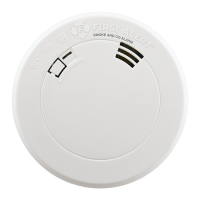
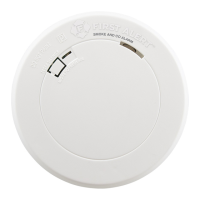
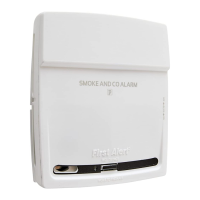
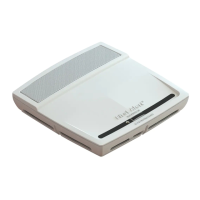
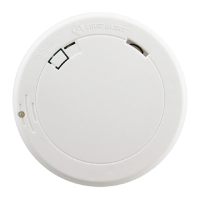
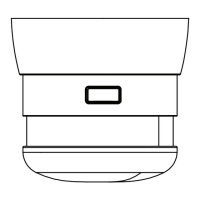

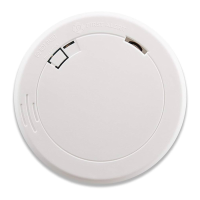
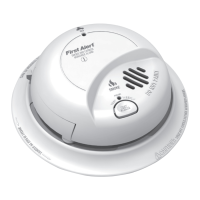
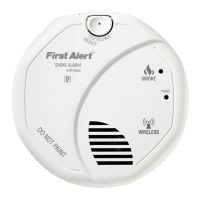
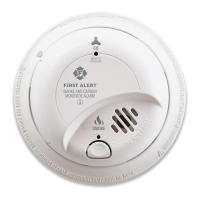
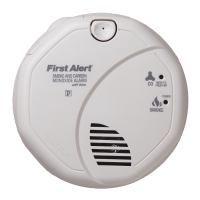
